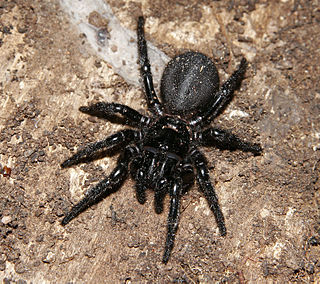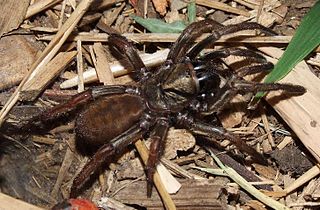
Hadronyche is a genus of venomous Australian funnel-web spiders that was first described by L. Koch in 1873. Originally placed with the curtain web spiders, it was moved to the Hexathelidae in 1980, then to the Atracidae in 2018.

Barychelidae, also known as brushed trapdoor spiders, is a spider family with about 300 species in 39 genera.

Aname is a genus of mygalomorph spiders. It is endemic to Australia. The spiders, as well as some in closely related genera, are also known as wishbone spiders. It was first described by Ludwig Koch in 1873.
Robert John Raven is an Australian arachnologist, being the Head of Terrestrial Biodiversity and the Senior Curator (Arachnida) at the Queensland Museum. Dr Raven has described over 450 species of spider in Australia and elsewhere, and is spider bite consultant to the Royal Brisbane Hospital, leading to much work on spider toxins.
Cethegus is a genus of mygalomorph spiders in the curtain-web family Euagridae. It s endemic to Australia and was first described by Tamerlan Thorell in 1881.

Arbanitis is a genus of Australian armoured trapdoor spiders that was first described by Ludwig Carl Christian Koch in 1874.
Cataxia is a genus of Australian armoured trapdoor spiders that was first described by William Joseph Rainbow in 1914.
Euoplos is a genus of armoured trapdoor spiders that is endemic to Australia. It was first described by William Joseph Rainbow in 1914.
Fijocrypta is a monotypic genus of South Pacific brushed trapdoor spiders containing the single species, Fijocrypta vitilevu. Both genus and species were first described by Robert Raven in 1994, and they have only been found in Fiji. It was first found in rainforests in the eastern highlands of Viti Levu, the largest island in Fiji, from which the species name is derived. The genus name is derived from "Fiji" and the Latin word cryptus, meaning "hidden".
Mandjelia is a genus of South Pacific brushed trapdoor spiders first described by Robert Raven in 1994.
Ozicrypta is a genus of Australian brushed trapdoor spiders first described by Robert Raven in 1994.
Tungari is a genus of brushed trapdoor spiders first described by Robert Raven in 1994. It is endemic to Australia. The name comes from an Aboriginal term meaning "song".
Australothele is a genus of Australian spiders in the family Euagridae. It was first described by Robert Raven in 1984.
Namirea is a genus of mygalomorph spiders in the family Euagridae. It is endemic to Australia, and was first described by Robert Raven in 1984.
Namea is a genus of spiders in the family Anamidae. It is endemic to Australia. It was first described in 1984 by Australian arachnologist Robert Raven. As of 2017, it contains 19 species, all from the states of Queensland (QLD) or New South Wales (NSW).
Moruga is a genus of Australian brushed trapdoor spiders, found in the states of Queensland (QLD) or Western Australia (WA), that was first described by arachnologist Robert Raven in 1994.
Cryptoforis is a genus of armoured trapdoor spiders. It is endemic to Australia. It was first described by Jeremy Wilson, Michael Rix and Robert Raven in 2020.
Seqocrypta bancrofti is a species of mygalomorph spider in the Barychelidae family. It is endemic to Australia. It was described in 1994 by Australian arachnologist Robert Raven. The specific epithet bancrofti honours Australian medical naturalist Thomas Lane Bancroft in recognition of his contributions to natural science.
Seqocrypta mckeowni is a species of mygalomorph spider in the Barychelidae family. It is endemic to Australia. It was described in 1994 by Australian arachnologist Robert Raven. The specific epithet mckeowni honours Keith McKeown, assistant curator at the Australian Museum, for his contributions to arachnology.
Seqocrypta jakara is a species of mygalomorph spider in the Barychelidae family. It is endemic to Australia. It was described in 1994 by Australian arachnologist Robert Raven. The specific epithet jakara is an Aboriginal term for the region in which the species is found.



